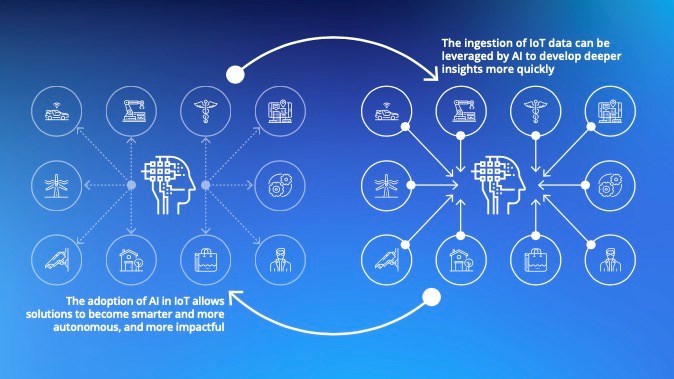
Source: Telenor
- A new report from Telenor looks at the combination of artificial intelligence (AI) and the internet of things (IoT) – AIoT or AI4IoT
- It suggests AIoT will be needed to make sense of the massive volumes of data that will be driven by IoT modules
- The key to success is access to reliable and ubiquitous comms networks and cellular connectivity – especially 5G
- The report calls for greater collaboration with ‘the right partners’
AIoT, or AI4IoT, a combination of artificial intelligence (AI) and the internet of things (IoT), will “emerge as the defining enabler for digital transformation”, according to a new report from Telenor and research house Omdia, as its adoption will be the only way that the vast volumes of data created by an increasing volume of IoT devices can be processed and analysed to provide useful end results.
According to the findings of the 2024 Telenor IoT Predictions Report, which carries the overblown subtitle ‘Navigating the perfect storm’, IoT applications will generate such massive quantities of data that “many enterprises will struggle to effectively analyse and extract meaningful insights from it.” It also notes that “simply collecting data does not bring value” and that “human intelligence can’t process the information as efficiently as AI. With the support of AI, applications become smarter and more autonomous.”
The report adds that the convergence of AI and IoT will be the key to improved operational efficiencies, a better customer experience all round, and will also result in higher productivity across sectors as diverse as automotive and industrial manufacturing to transport, utilities, and smart cities. It claims that the combination “can turn simple solutions into those with greater impact and value” and cites predictive maintenance, improved robotics and “enhanced in-car experiences” as prime examples of AIoT use cases.
The CEO at Telenor Connexion and head of Telenor IoT, Mats Lundquist, commented, “We predict AIoT will grow to become the cornerstone of digital transformation. The convergence of AI and IoT isn’t just an evolution; it’s a revolution in how businesses operate and compete globally. This report emphasises the urgency to act now.”
Smart devices will become an integral part of an ‘intelligent system’
Omdia makes the point that the wave of digital transformation now coursing around the globe is having a profound effect on IoT and estimates that the worldwide base of installed IoT devices was hovering at about 38 billion at the end of 2023. The incredible amount of data being generated currently accounts for about 1 billion gigabytes of data per day. By 2030, forecasts are that there will be upwards of 82 billion IoT devices in use and the amount of bandwidth that traffic will chomp through is yet to be estimated but it will be truly massive.
Eventually moving from generalisation to some practical detail, the report lists a series of factors that it is believed will drive the adoption of AIoT over the course of this year. These include the increasing willingness of businesses to use AI: According to the Omdia IoT Enterprise Survey, over 48% of enterprises prioritise AI and machine learning in IoT deployments. Another driving factor is the innovation in supporting hardware – improvements in semiconductor technology, including AI edge processors, are set to provide enhanced computing power for AI integration.
Another determinant is “AI model optimisation” wherein the AI model size is minimised. This is TinyML, which allows data to be processed on edge devices, thus doing away with the requirement to transfer data to a server (such transfers can cause significant processing delays). TinyML also uses less power than traditional machine learning models, enabling it to operate for long periods without needing to be charged. It can work offline and its models run on small, low-powered devices like microcontrollers, giving devices and sensors a new level of intelligence without requiring an internet connection.
A fourth aspect is generative AI (GenAI): Some 38% of respondents in Omdia’s 2024 IT Enterprise Insights reported that they had either already fully adopted generative AI or were implementing it, while only 10% said they had no interest in the technology. The adoption of GenAI is expected to lead to the automation of software code generation which, in turn, could accelerate the coding of IoT applications.
– Martyn Warwick, Editor in Chief, TelecomTV
Email Newsletters
Sign up to receive TelecomTV's top news and videos, plus exclusive subscriber-only content direct to your inbox.




